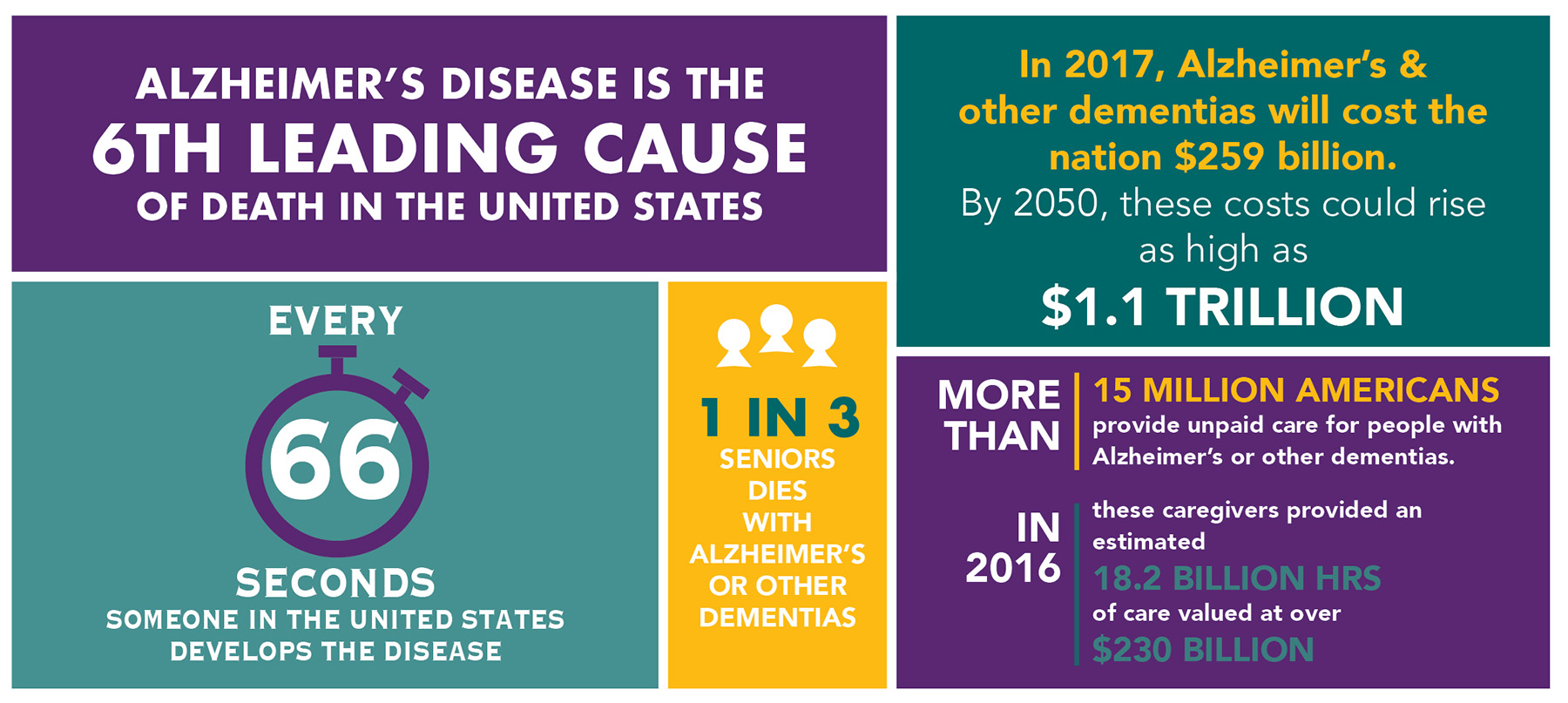Alzheimer’s by the Numbers
NewsThe number of Americans living with Alzheimer’s disease is growing — and growing fast. An estimated 5.5 million Americans of all ages have Alzheimer’s disease.
Of the estimated 5.5 million Americans living with Alzheimer’s dementia in 2017, an estimated 5.3 million are age 65 and older and approximately 200,000 individuals are under age 65 and have younger-onset Alzheimer’s.
- One in 10 people age 65 and older (10 percent) has Alzheimer’s dementia.
- Almost two-thirds of Americans with Alzheimer’s are women.
- African-Americans are about twice as likely to have Alzheimer’s or other dementias as older whites.
- Hispanics are about one and one-half times as likely to have Alzheimer’s or other dementias as older whites.
Because of the increasing number of people age 65 and older in the United States, particularly the oldest-old, the number of new cases of Alzheimer’s and other dementias is projected to soar. Today, someone in the United States develops Alzheimer’s dementia every 66 seconds. By mid-century, someone in the United States will develop the disease every 33 seconds.
Alzheimer’s disease is the sixth-leading cause of death in the United States. It is the fifth-leading cause of death among those age 65 and older and a leading cause of disability and poor health.
As the population of the United States ages, Alzheimer’s is becoming a more common cause of death. It is the only top 10 cause of death that cannot be prevented, cured or even slowed.
Although deaths from other major causes have decreased significantly, official records indicate that deaths from Alzheimer’s disease have increased significantly. Between 2000 and 2014, deaths from Alzheimer’s disease as recorded on death certificates increased 89 percent, while deaths from the number one cause of death (heart disease) decreased 14 percent.
Among people age 70, 61 percent of those with Alzheimer’s are expected to die before the age of 80 compared with 30 percent of people without Alzheimer’s — a rate twice as high.
In 2016, 15.9 million family and friends provided 18.2 billion hours of unpaid assistance to those with Alzheimer’s and other dementias, a contribution to the nation valued at $230.1 billion.
- Approximately two-thirds of caregivers are women, and 34 percent are age 65 or older.
- 41 percent of caregivers have a household income of $50,000 or less.
- Approximately one quarter of dementia caregivers are “sandwich generation” caregivers — meaning that they care not only for an aging parent, but also for children under age 18.
Alzheimer’s takes a devastating toll on caregivers. Compared with caregivers of people without dementia, twice as many caregivers of those with dementia indicate substantial emotional, financial and physical difficulties.
The costs of health care and long-term care for individuals with Alzheimer’s or other dementias are substantial. Dementia is one of the costliest conditions to society.
Total payments in 2017 for all individuals with Alzheimer’s or other dementias are estimated at $259 billion. Medicare and Medicaid are expected to cover $175 billion, or 67 percent, of the total health care and long-term care payments for people with Alzheimer’s or other dementias. Out-of-pocket spending is expected to be $56 billion.
Health care costs increase with the presence of dementia.
- People with Alzheimer’s or other dementias have twice as many hospital stays per year as other older people.
- Medicare beneficiaries with Alzheimer’s or other dementias are more likely than those without dementia to have other chronic conditions.
- People with Alzheimer’s or other dementias make up a large proportion of all elderly people who receive adult day services and nursing home care.
Total per-person health care and long-term care payments in 2016 for Medicare beneficiaries with Alzheimer’s or other dementias were over three times as great as payments for other Medicare beneficiaries. Average per-person out-of-pocket costs for Alzheimer’s and other dementias are almost five times higher than average per-person payments for seniors without these conditions.
Total annual payments for health care, long-term care and hospice care for people with Alzheimer’s or other dementias are projected to increase from $259 billion in 2017 to more than $1.1 trillion in 2050. This dramatic rise includes more than four-fold increases both in government spending under Medicare and Medicaid and in out-of-pocket spending.
Source: http://www.alz.org



